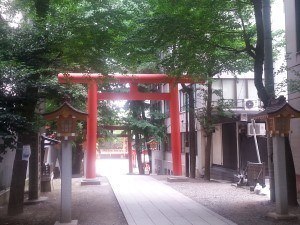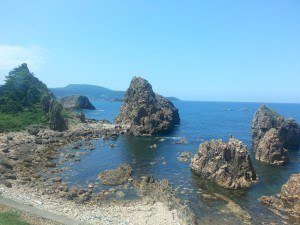Remote Japan - Off the beaten track



Remote Japan - Off the Beaten Path
Many tours to and around Japan involve the well
known sights along the "Golden Route" between Tokyo and Kyoto, and may
include extensions down to
Hiroshima. The typical highlights include things like Mt Fuji, Kinkakuji (the golden pavilion),
Kiyomizu-dera, Himeji Castle and the floating torii gate at
Miyajima. These trips often cater for the mass market and bus tour groups
that simply work through a set list in crowded locations.
While Japan Custom Tours also can cover these sights
for you (in a less crowded way) as your travel guide, for a more authentic
experience, we offer tours that take you off the beaten track in Japan.
This allows you to immerse yourself in aspects of rural Japan, or to head to the
non-touristy places, away from the crowds and to some of the less travelled
parts of Japan. Our the feedback from our guests is that these experiences
provide a more intimate and a more genuine window into the country, culture and
scenic beauty.
As we customise trips for our guests, we do not have set schedules or routes,
but retain flexibility to design something that suits your interests. To
provide some inspiration we have included a couple of examples of the places we
consider visiting (and there are certainly many more hidden gems or Japan worth
exploring).
If you are interested in joining one of our Remote Japan tours,
you can use the contact us form or email us at
admin@japancustomtours.co.nz.
We will then work with you to personalise the schedule of your tour off the
beaten path and work around your preferred travel dates. That might
include adding in some of the more popular or famous "must see" sights as part
of your custom tour, or heading to some locations where you can simply discover
Japan you might not have known existed.
Sample Schedules - Remote Japan
The schedule for the Remote Japan tours depends on
guest preferences, season and activities. So rather than having a set
schedule, we can take you to explore a range of different places and link with
interesting and some of the most scenic train journeys around the country.
We include a couple of samples to give a flavour of the trips that we have
organised.
Kansai Regional Tour
Day 1 Tokyo to Toba: Toba, Mikimoto and Pearl Island for the museum and
see the Alma pearl divers. The aquarium is good and a small cruise around the
bay and islands adjacent to the town. Our previous visits included accommodation
at the Ryosou Uminochou Ryokan (a mix of Western/Japanese style) or the Toba
International with views across the ocean.
Day 2 Toba: Visit the Ise Grand Shrine. This is a major complex of
buildings and some 125 shrines. Included is the Ujibashi bridge which is rebuilt
each 20 years. Access is by train from Toba and a short walk to Ise Jingu
Geku. Ise Jinju Naiku is a longer walk or 10 minute bus/taxi (we get either a taxi
or bus). At Ise Jinju Naiku is an interesting collection of shops and
restaurants themed in an old style. While this is a major destination for many
domestic tourists/pilgrims, few foreigners make the trip.
Day 3 Toba to Koyasan: A transfer day to Koyasan - arrival would be in
the afternoon timed with the accommodation check-in (usually 3 p.m.) For a
stay at Koyasan we have looked for ryokan with Japanese-style rooms
including breakfast and dinner. Our preferred option includes a room size is about double most of the other options
in the local area.
Day 4 Koyasan: A full day to explore Koyasan and area. Many people
seem to just stay a single night so please advise your preference.
Day 5 Koyasan to Shirahama: A day to back-track from Koyasan to the
seaside town of Shirahama as a location to explore the Kudamo Koda pilgrim trails
on the Kii peninsula. Depending on how energetic you are, there are some good
walking/hiking trails, temples and shrines.
Day 6 Shirahama - Kumano Kodo: A full day to explore the old pilgrimage
trails and famous shrines like Hongu Taisha. Access to the Hongu Taisha area is
by bus, approximately two hours.
Day 7 Shirahama to Kyoto: From the eastern part of Japan head back
towards the centre of the island. To limit the travel on any one day we stop in
Kyoto. Plus there is more than enough to entertain in the old capital.
Day 8 Kyoto: A full day in Kyoto to do some less common activities.
Day 9 Kyoto to Togura/Nagano: Head into the mountains via Matsomoto (the
castle is an optional stop) for a stay at a
traditional Japanese inn including onsen and local foods prepared on-site. There
is a small castle (fort) on the hill behind the ryokan that gives great views
across the valley and mountains around the area. There is a local cycling tour
around Togura available opposite the ryokan. A highlight for many of our guests
is for entertainment by the local geisha who provide dinner entertainment (music and dance).
Day 10 Togura/Nagano: Several options are available. Explore the local
town, the city of Nagano and Zenko-ji temple in Nagano, founded in the 7th
century, Togakushi Shrine in the forest to the north-west of Nagano, with its
impressive tree-lined approach and Ninja Museum, or Jigokudani Monkey Park.
Day 11 Nagano to Tokyo: A short trip back to Tokyo for time sightseeing
in the city or additional day trips to nearby areas.
Tohoku Regional Tour
Day 1 Tokyo to Sendai: Taking an early train head to Sendai and
Matsushima Bay, one of the three "views of Japan" and the cruise around the bay
with its many beautiful pine-tree covered islands. After viewing the pine
covered islands, walk to Zuigan-ji past the caves carved into the approach to
the temple. The caves were used for memorial services and as a cinerarium to
house the ashes of the deceased. The caves were constructed some 700 years ago
and remained in use until a few hundred years ago.
Day 2 Sendai to Aomori: Taking the Hayabusa shinkansen at speeds up to
320 km/h travel to Aomori. There will be time during the afternoon to see Wa
Rasse, a museum celebrating the summer Nebuta festival, or the floating car
ferry museum in the port area.
Day 3 Aomori: There is a day trip to Mount Osorezan (one of the most
sacred sites in Japan) or visit the extreme end of the island at Cape Oma.
Another option is to visit the nearby town of Hirosaki, famous for its castle
and park (with 2600 cherry trees - blossom time is late April or early May).
Day 4 Aomori to Akita: From Aomori to Akita is one of the most scenic
train trips in Japan around the north west coastline.
Day 5 Akita: A relaxation day allowing short trips to Lake Tazawa, a
visit to the Senshu-koen park, or go to Kakunodate to explore the old Samurai
district and houses.
Day 6 Akita to Niigata: Continue our journey along the western coast to
Niigata.
Day 7 Niigata: Visit Sado Island by jetfoil. The remoteness of
the island made it ideal for exiles and retains a distinct "out of the way"
atmosphere. Niigata also has an old style market - Hon-cho.
Day 8 to Togura/Nagano: Head into the mountains for a stay at a
traditional Japanese inn including onsen and local foods prepared on-site.
Explore the local town and enjoy the hot spring baths. Included is a
private geisha entertainment.
Day 9 Togura/Nagano: Several options are available. Explore the local
town, the city of Nagano and Zenko-ji temple in Nagano, founded in the 7th
century, Togakushi Shrine in the forest to the north-west of Nagano, with its
impressive tree-lined approach and Ninja Museum, or Jigokudani Monkey Park.
Day 10 Nagano to Tokyo: A short trip back to Tokyo for time sightseeing
in the city or additional day trips to nearby areas.
Price Inclusions/exclusions
Pricing is takes into account the accommodation rates that we expect to be in
place at the time of bookings. The tour price reflects the fact that rates are
lower when booked in advance, and more expensive when booked shortly before the
tour commences.
The price for a fifteen days (accommodation for fourteen
nights) is from Y595,000 per person share twin/double. Shorter or longer duration is also available.
For solo travellers (one person, without a shared room), the cost of
accommodation is unable to be shared, but we have a policy to limit the extra
cost and have priced our tour for a single person at JPY695,000. An early
confirmed booking discount would also apply.
Prices include rail transfers from Narita to Tokyo and
14 day rail pass, entrance fees and tour fees. Accommodation
is selected to average 4-star or higher and will normally include breakfast. Please let us know if you would like
either twin or double beds.
Lunch, dinner and incidental costs are usually excluded unless specifically
included. As a
guide for budgeting, Y7,000 per day per person would cover lunch and
dinner as well as a range of tea/coffee, snacks and vending machine drinks
during the day.
Bookings and Inquiries
If you are interested in joining a remote Japan, off the beaten path tour, please contact us or email us
directly at
admin@japancustomtours.co.nz.
Send mail to admin@japancustomtours.co.nz with questions or comments about this web site.
Copyright 2014
Last modified: 31 December 2017



![[Company Logo Image]](https://d3bb6cic8t0vq8.cloudfront.net/images/logo.gif)